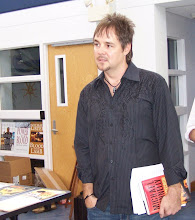
“Synecdoche, New York” is such a devastating, profound, and true masterwork of art I feel unequal to the task of telling you just how extraordinary, rare, stunning, and heartbreaking it really is.
Just two weeks ago, in this very column, I was celebrating the brilliance of Charlie Kaufman, proclaiming “Eternal Sunshine of the Spotless Mind” to be the brightest object in his creative constellation. Now, after having seen “Synecdoche, New York,” I’m saying that what “Eternal Sunshine of the Spotless Mind” does for love and memory, “Synecdoche, New York” does for virtually everything else—most notably life, art, meaning, aging, dying, and death.
The thing about life is, we die. That’s it. What does it mean to be human, but that we will one day be no more, and we are aware of it—some of us quite acutely.
When the film’s protagonist, Caden Cotard, tells his cast and crew about the new play he wants to stage, he says, “I’ve been thinking a lot about death lately. That’s what I want to explore. We’re all hurtling toward death, yet here we are for a moment alive, each of us knowing we’re gonna die, each of secretly believing we won’t.”
Claire Keen, one of the female actors, responds, “That’s brilliant . . . It’s everything.”
And though she says it out of a worshipful infatuation with Caden, it’s no less true.
More than any other film I can recall, “Synecdoche, New York” is so rich and multi-layered, its deepest profundity in the subtext, that it seems silly to try to tell what it’s about, but here goes:
Theater director Caden Cotard is mounting a new play. Having won a MacArthur grant, he is determined to create a piece of brutal realism, something he can put his whole self into. He gathers an ensemble cast into a warehouse in Manhattan’s theater district and directs them in a celebration of the mundane, instructing each to live out their constructed lives in a small mockup of the city outside. As the city inside the warehouse grows, Caden's own life veers wildly off the tracks. Populating the cast and crew with doppelgangers, he continually blurs the line between the world of the play and that of his own deteriorating reality.
The title is a play on Schenectady, New York, where part of the film is set. Synecdoche (pronounced si-NEK-duh-kee), from a Greek word meaning “simultaneous understanding,” is a figure of speech in which a term denoting a part of something is used to refer to the whole thing. In the film, the play represents life, and so a part of life represents the whole of life and the New York within the play represents the New York outside the warehouse where it’s being staged.
Does life imitate art? Do we each have doppelgangers wandering around, unseen by us, unknown to us, or, are we all one another’s double—interchangeable in ways we can’t even fathom because of our shared humanity and futility, in that we are alive and soon won’t be? And like Caden’s characters, women are interchangeable with men and vise versa (very Jungian anima/animus), because what we have in common—our mortality—makes us far more alike than not. In Caden’s play, “All the world’s a stage, And all the men and women merely players; They have their exits and their entrances, And one man in his time plays many parts.”
Even as “Synecdoche, New York” is full of people interacting—some of them intimately—and even though there are doubles and doppelgangers, ultimately, like us, Caden is alone. In addition to everything else, the film, the play within the film, and Caden’s journey, are about loneliness. The characters of the film, the actors in the play—even as they connect and share and become one another—are, like you and me, ultimately, utterly alone.
Just two days after experiencing Caden’s utter aloneness, I found myself alone at a funeral. Over the years, I’ve attended and spoken at a lot of funerals, but this was the only one I ever recall going to and sitting at alone, and as I sat there alone thinking about the birth, life, and death of the person who was alone in the box before me, I couldn’t help but think of Caden, couldn’t help but feel profoundly alone. And yet, having shared Caden’s journey made me less alone somehow—or perhaps made my aloneness more bearable.
“Synecdoche, New York” must be watched multiple times. When you finish it the first time, start it over and watch it again. But even with numerous viewings, we won’t understand everything in the film—and we’re not meant to. Life is mysterious. Art that reflects it, the very kind of brutally truthful art Caden is trying to make, will be mysterious, will be, in many ways, incomprehensible. In life, in art, in religion, there aren’t merely vague unknowns, but specific unknowables.
Though I think artists will likely relate to Caden most, there’s plenty in his journey for everyone—for it’s our journey, the betrayal of us by of our bodies, loss, regret, unrecognized potential, what is never quite living up to what might have been, sickness, suffering, aging, dying, and death.
Perhaps the word “genius” is tossed around too indiscriminately these days, but it fits here. Charlie Kaufman is truly a genius. His work requires us to work and then rewards us greatly for it. “Synecdoche, New York” isn’t just a great film, it’s perhaps one of the greatest films ever made. Like life, “Synecdoche, New York” is heartbreaking and painful, some parts particularly difficult to watch. It’s not an easy film, not easy at all, but it’s a worthy film—worth every moment invested into it. How many movies can you say that about?
Perhaps the greatest compliment I can give this matchless masterpiece of a play within a film is that it evokes within me echoes of the world’s greatest playwright, particularly these haunting, desolate, immortal words that now seem to have been written for Caden Cotard: “All our yesterdays have lighted fools; The way to dusty death. Out, out, brief candle! Life's but a walking shadow, a poor player; That struts and frets his hour upon the stage; And then is heard no more: it is a tale; Told by an idiot, full of sound and fury, Signifying nothing.”
Of course, that such words can be written, that such tales can be told argues against the very notion it expresses to signify something. Quite something. And that’s not nothing. In fact, it just might be everything.












No comments:
Post a Comment